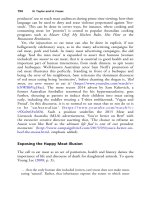The palgrave international handbook of a 205
Bạn đang xem bản rút gọn của tài liệu. Xem và tải ngay bản đầy đủ của tài liệu tại đây (38.47 KB, 1 trang )
198
N. Taylor and H. Fraser
Gruen, L. (1993). Dismantling oppression: an analysis of the connection between
women and animals. In G. Gaard (Ed.), Ecofeminism: women, animals, nature
(pp. 60–90). Philadelphia: Temple University Press.
Hamilton, L., & Taylor, N. (2013). Animals at work: identity, politics and culture in
work with animals. Boston and Leiden: Brill.
Jenkins, S., & Twine, R. (2014). On the limits of food autonomy—rethinking
choice and privacy. In N. Taylor & R. Twine (Eds.), The rise of critical animal
studies: from the margins to the centre (pp. 225–240). London: Routledge.
Jepson, J. (2008). A linguistic analysis of discourse on the killing of nonhuman
animals. Society & Animals, 16(2), 127–148.
Kimmel, M. (2013). Angry white men, American masculinity at the end of an era. New
York: Nation Books.
Le Duff, C. (2003). At a slaughterhouse, some things never die. In C. Wolfe (Ed.),
Zoontologies. Minneapolis: University of Minnesota Press.
McHugh, S. (2004). Dog. London: Reaktion Books.
Meat and Livestock Australia (MLA) (2015). ‘You’re better on Beef’ the message
behind MLA’s latest marketing campaign via BMF. paignbrief.
com/2015/03/youre-better-on-beef-the-messa.html. Accessed 13 October 2015.
Murray, M. (2011). The underdog in history: serfdom, slavery and species in the
creation and development of capitalism. In N. Taylor & T. Signal (Eds.),
Theorizing animals: re-thinking human animal relations (pp. 85–106). Boston and
Leiden: Brill.
Nibert, D. (2002). Animal rights/human rights. Entanglements of oppression and
liberation. Lanham, MD: Rowman and Littlefield.
Noske, B. (1997). Beyond boundaries: humans and animals. New York: Black Rose
Books.
Pachirat, T. (2011). Every twelve seconds: industrialized slaughter and the politics of
sight. New Haven and London: Yale University Press.
Piazza, J., Ruby, M., Loughnan, S., Luong, M., Kulik, J., Watkins, H., et al. (2015).
Rationalizing meat consumption. The 4 Ns. Appetite, 91, 114–128.
Pilgrim, K. (2013). ‘Happy Cows,’ ‘Happy Beef’: a critique of the rationales for
ethical meat. Environmental Humanities, 3, 111–127.
Regan, T. (2001). Defending animal rights. Chicago: University of Illinois Press.
Roe, E. (2010). Ethics and the non-human: the matterings of animal sentience in
the meat industry. In B Anderson & P Harrison (Eds.), Taking place: nonrepresentational theories and geography (pp. 261–280)). Aldershot: Ashgate.
Ruether, R. (1975). New heaven/New earth: sexist ideology and human liberation.
New York: Seabury.
Small, S. (2014, October 24). Nearly 700 sharks killed in Queensland’s cull program
but conservationists say no evidence it works. ABC News. />news/2014-10-24/nearly-700-sharks-killed-in-queensland-this-year/5839188.
Accessed 21 November 2015.









